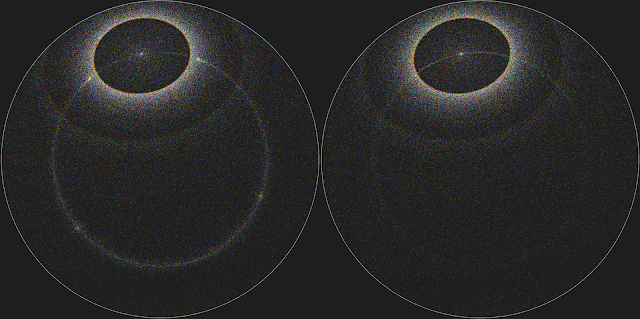The two displays above have both a faint parhelic circle, but the one on the right has a notable omission: there are no parhelia. These photos (12 and 7 frame stacks of about 2 minute exposures) were taken in Rovaniemi on the night of 3/4 January, in different locations and 3 hours between them. In Taivaanvahti less heavily edited versions are shown.
With the moon at 33 degree elevation in the right hand image – which was the latter shot of the two – the parhelia should be far enough outside the 22° halo to avoid being masked by it (even with its puffed up form). It seems to me the only explanation for this solitary parhelic circle is to assume special plate oriented crystals that allow only for an external reflection. Below are two simulations to illustrate this. The simulation on the left has the hits limit at 100 for both plate and random populations, on the right for the plate population only one hit was allowed – an external reflection. This gives the parhelic circle without parhelia.
Should this be the correct explanation, one may still ask why the restriction to external reflection applies only to plate oriented and not to random oriented crystals. Maybe there is something else going on here that has not occurred to me. In 2017 my camera captured a similar case.
EDIT 25 Jan: Added above a third simulation to imitate a buffed up 22° halo. It has 22, 23, 24° halos of about equal brightness. The parhelia are still outside of this broad ring.
I include also two spotlight views from this night. They were taken before I photographed the lunar display in the left hand image. Odd radius halos are visible, 24° plate arcs and 35° halo. Temperature was -20 C. Some more photos are shown in Taivaanvahti. The apparent 9° stuff in the right hand lunar photo is probably an artefact, the appearance of these features seemed to depend on the values of image enhancement.
The camera is Canon 40D, the same one that I have been using since the start of the season. It is gone now, it broke when I was ready to photograph a great plate display the another night. Even if this camera leaves much to be desired, such as dynamic range, the line noise, not having an integrated intervalometer, it is quite good where artefacts are concerned. Serious color banding artefacts are not a problem with this body.





In 2005 I got a display that had parhelic circle, CZA and 120d parhelia but no regular 22d parhelia
ReplyDeleteSo this parhelialess parhelic circle was passing through the parhelia location? If the display had also column halos, the missing of parhelia could be explained by a local segment of column only parhelic circle.
ReplyDeleteIn this Rovaniemi display perhaps the plates were very thin. To have parhelia in such crystals at 33 light source elevation requires ping-pong of basal face reflections for the light to make the trip. If I use h/d 0.02 regular hexagons in HaloPoint the typical parhelia rays for 33 degree light source elevation are like this:
32121212121212121215
That is nine pairs of basal face reflections. If the crystal is not optically perfect, then this may no be possible.
Yeah it passed thru where parhelia were and there were no tangent arcs at all an the CZA looked weird too
DeleteHi Michael, did you manage to photograph this display back in 2005? It would be interesting to compare the images if you did.
DeleteYep I got pics of it.
DeleteAny chance of sharing these with Marko so that he can compare the two displays? Thanks.
DeleteYes but since I have been working overtime I will do it this weekend. I wished I would of gotten more pics near the sun but I did see almost no parhelia near the sun but the PHC was well defined and the were bright 120s parhelia and the CZA looks a bit like an upper 46d Galle arc. Its a weird display indeed
DeleteThanks Marko for presenting this interesting display and analysis. Michael, I too would love to see those images.
ReplyDeleteAs to the camera, I believe (and Marko and I looked into this) that some of the artifacts are not baked into the raw file and thus the result on poor camera electronics. Some appear in conversion and in various locations depending on the conversion settings. We would benefit from a throrough converter comparison for some test files. It would be super interesting.
I will post them this weekend on a separate post
DeleteThat's a peculiar case indeed. We got a display here in China back in 2019 that involves a solitary parhelic circle: https://weibo.com/2539943557/I8LxXdTK0
ReplyDeleteIt's possible though the parhelia will eventually show up in stacks but unfortunately the photographer only grabbed a few shots.
Yeah, that would need stacking to see if they really were absent, because with that high sun, the parhelia are already quite faint.
ReplyDeleteThere are also different kind of peculiar no-parhelia cases:
https://1.bp.blogspot.com/-xguNAMlSoeM/Xt9lfw3dmQI/AAAAAAAAApQ/pzxCgdVHJEIiGEKeMOUCPc1QaxgMn_9EQCK4BGAsYHg/s1488/rapy.png
http://www.thehalovault.org/2017/02/problematic-arcs-in-spotlight-display.html
In the latter case (the main image) there is no subparhelia either, but I still find it odd that at the parhelia level there is nothing.
About the artefact issues that Jari brought up above, I am thinking of making a little post to demonstrate them with the solar odd radius display I photographed two weeks ago. Yeah, it is quite interesting.